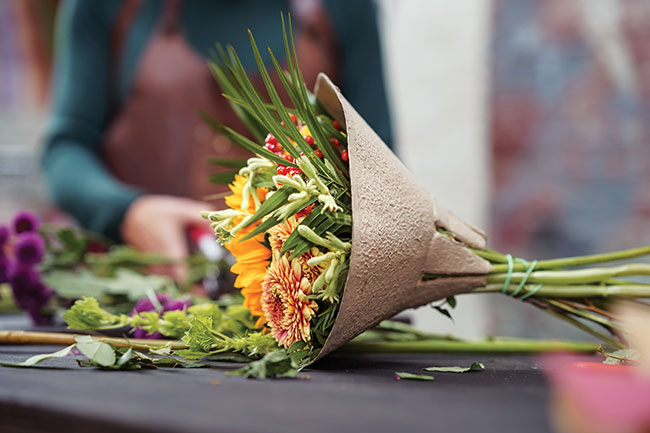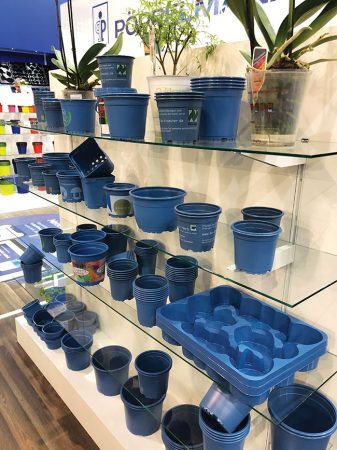
Features
Business
Flowers
Marketing
Retail
Trends
The plight of plastic in the ornamental sector
Consumers may want to see less plastic in their ornamental products, but eliminating it may not be the answer.
February 18, 2020 By Anne-Marie Hardie
 As consumers become more aware of single-use plastic waste, retailers look for alternatives.
Photo credit: Decowraps
As consumers become more aware of single-use plastic waste, retailers look for alternatives.
Photo credit: Decowraps Whether it’s pots, trays or wraps, single-use plastic is becoming a mounting concern for growers, retailers and the end consumer. This is not a new challenge for the industry as discussions around more sustainable solutions have been ongoing for the past decade. However, the conversation has become amplified lately as Canadians have grown increasingly aware of their plastic waste.
According to the 2019 Economic Study of the Canadian Plastic Industry, Canada throws away 87% of its plastics, valued at $7.8 billion. Canada’s recycling statistics are dismal as the report shows how Canada recycles just 9% of its plastic waste. The Canadian government has announced that it is time to change, including a plan to ban single-use plastic by 2021, working with partners to deliver their vision of zero plastic waste.
Each year, the horticulture industry sells its products in single-use plastic pots, trays and wraps – the majority of which end up in landfill. Recycling programs, such as the one for horticultural plastics launched by Landscape Ontario in 2008 and run by the Canadian Nursery Landscape Association, were shut down when China closed its doors to poor quality and certain types of plastic. Other Asian countries similarly heightened their restrictions on acceptable plastic or banned plastic waste imports altogether.
Recycling single-use pots and trays in Canada is extremely challenging. Soil and debris need to be removed to prevent cross-contamination and containers have to be separated based on their various plastic films. Because the plastic makeup of standard black pots cannot be identified by near-infrared (NIR) light used at most recycling facilities, those containers cannot be sorted and recycled.
‘Recycled’ doesn’t mean ‘recyclable’
There are risks to adopting more sustainable solutions, including higher upfront investments and ensuring that the containers retain the same functionality as their single-use alternatives. To make these solutions work, growers may need to charge a higher premium. But can the current economic environment adapt to this price increase? If the retail industry is any indicator, now is the time to explore sustainable alternatives. The 2019 Canadian Consumer Insights Survey reported that 42% of Canadian consumers actively seek to avoid plastic packaging in their groceries, and 32% are willing to pay more for non-food items that are sustainably packaged.
“We’ve seen a steadily increasing demand for sustainable pot alternatives. Consumers are willing to pay more for pots that they know are 100% recyclable and made from post-consumer recycled material,” says Lindsay Childers, TEKU sales manager for Pöppelmann.
Three years ago, Pöppelmann launched their corporate ‘blue’ initiative to close the material loop, aiming to put post-consumer plastic waste back into the production of new pots. “Just because a pot is marketed as being made from recycled material, doesn’t mean it is 100% recyclable,” says Childers, underscoring the importance of knowing where the material for the pots came from and their fate after disposal. According to Pöppelmann, the product must satisfy three conditions to close the material loop: it must be recyclable, it must be made from post-consumer recycled plastic and it must return to the same point in the recycling process from where the source material was acquired.
To this end, the plastics manufacturer developed a four-level classification system used to describe their product lines:
‘Circular360’ pots are made from 100% post-consumer household waste. They can be easily sorted at recycling and directed back to plastic manufacturers for new pots to be made. Pots are indicated by their distinctive ‘circular blue’ colour.
‘PCR Recyclable’ pots contain 100% post-consumer recycled plastic. This may include sources other than household waste, such as garden furniture.
‘Recyclable’ pots are made from a mixture of post-consumer, post-industrial and some virgin material. Post-industrial materials are sourced from waste generated through industrial plastic processing.
The fourth and final level of classification is for black pots. Though made from a mixture of post-industrial and virgin materials that are technically recyclable, the black colour renders the pots unreadable by NIR and therefore not processed by most recycling facilities.
Pöppelmann’s goal was to design a range of pots that responded to a variety of sustainability concerns, while still retaining the design and performance elements of their original products. The cost of these pots range from ten to thirty-five per cent more than the standard pot.
JVK is one Canadian supplier that has added Pöppelmann’s blue pots to its product line. “All plastic is recyclable; the challenge is whether your municipality will accept it and if not, what the consumer can do with that material,” says Chris Johnston, vice president of sales and marketing at JVK. With the blue pots, not only are the products created from post-consumer household waste, they come in a colour that can be read and recycled by local municipalities.
As Johnston explains, the loop in Canada is different from the one described by Pöppelmann. The plastic isn’t going back to the region in which it was produced as most horticultural container manufacturers are located elsewhere. “However,’ he adds “we could have a closed loop where plastic is reused in the area in which it is first sold to or used by consumers.” As demand picks up, he foresees more post-consumer household waste being diverted towards resin pellets for manufacturers to use. “Thus, multiple-use plastic with what could be a low-carbon footprint, if done regionally.”

Pöppelmann’s Circular360 products come in a distinctive ‘circular blue’ colour. Photo credit: Greenhouse Canada
An Individualized Approach to Sustainability
In some cases, plastic may be the more sustainable solution. “For production, you need plastic, but retailers can choose to have the trays returned for reuse or opt for recyclable plastic,” says Johnston.
Instead of eliminating plastic, Herkuplast International has focused on creating something that will fulfill their customers’ propagation needs while reducing single-use products. Their Quickpot trays are crafted from durable, polystyrene film, with the average tray lasting anywhere from 8 to 10 years. “It’s simply a better investment both financially and environmentally,” states Alfred Boot, sales director at Herkuplast International. “Although the initial cost is approximately three times more than a single-use tray, the durable trays work extremely well on fully automatic lines and can be reused for several years.”
When considering sustainable options, it is important to investigate the entire carbon footprint of the product, including the process involved in creating it and disposing of it. Where available, biodegradable solutions may appear to be the better solution. However, it may be more sustainable for growers to choose alternatives that can be sanitized and reused or ones that are created from recycled materials. “If we are able to pick up old plastic and only need to add a small percentage of new material to create a new product, then that may be a better solution than opting for a new product that is biodegradable,” says Boot. Ultimately, it is up to the grower to determine what works best for their operation.
Connecting Consumers with the Story
Johnston emphasizes that when looking at sustainable alternatives, growers would benefit by paying attention to their entire operation and seeking options that would help decrease the amount of plastic waste generated. This may include biodegradable containers, cardboard carriers to transport non-plastic pots, or containers created from recycled plastic. But the key to successful acceptance of these sustainable alternatives is ensuring that the end consumer understands. “We need to start communicating when we are using sustainable packaging,” says Johnston. “If this one is greener or more sustainable, shoppers will probably lean towards that solution – but growers and retailers need to communicate that information.”
Aileen Flicki, product manager at Decowraps, echoes Johnston’s statement about there being multiple ways to integrate sustainability into a growing facility. “We are helping our customers find materials and tools to help them tell their story,” says Flicki. “But before doing that, growers need to discover what their story is.”
The narrative is much more extensive than simply eliminating single-use plastic. It should include the source of the product, how it is produced, and what happens to the product at the end of its life. Decowraps’ vast product selection allows their clients to connect with their customers and select materials to help them share the story. New materials are sometimes sourced to fit production needs. Current options include clear, compostable PLA made from corn, kraft paper that has been FSC-certified for sustainable production, as well as others in the works. They also offer a flexible and opaque Bio-LDPE made from sugarcane that carries the “I’m Green” seal, a recognized certification that helps the consumer identify packaging products made with bio-based resin Bio-PE, a polyethylene made from renewable resources.
The key is ensuring that adopted solutions are both economically viable and sustainable. In most cases, this may mean that growers would need to increase the price of the product. “These options may be a bit more expensive, but with the right message, consumers are open and willing to pay for these sustainable solutions,” says Johnston. “The Pöppelmann blue pots, for example, are different than other products on the market because they are made from consumer household waste. It is these types of stories that need to be shared with the end consumer to help drive the demand.”
To help make this shift as an industry, growers need to find a way to market their products’ sustainability story; this includes focusing on what sustainability means to them, as a company, and how they want to present this to the end consumer. “It’s really about the story you want to share on the product, and the packaging solution connects to that story,” says Flicki.
The conversation is starting with consumers and moving up to retailers. Greater pressure will then be placed on suppliers to reduce plastic waste. In time, this movement will drive the sector to adopt more sustainable solutions as a long-term approach to reducing waste from single-use plastic.
Print this page